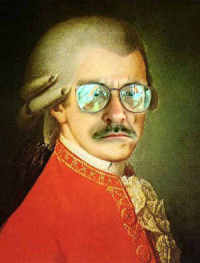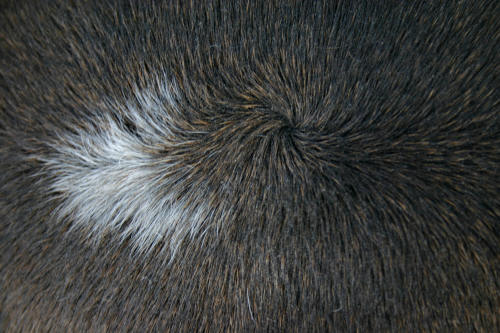A 365-Day Project
"We Are All Mozart"
A project to create
new works and change
the perception of the
music of our time.


 October 8, 2006
October 8, 2006 
The past two nights were performances by the Vermont Contemporary Music Ensemble in a concert entitled "Winds of Change" -- a double-entendre of a concert of wind music and the hint that the group is about to split off a separate wind trio of flute, clarinet and bassoon. Various names were suggested (AirHeads, Sea of Holes, Typhoon, WindJammies...) at the bar watching the baseball game after a quite fine second concert.
The program was in many ways a celebration of short forms, including Four Bagatelles by Allan Blank, The Last Kind Day by Patricia Julien, Turns by Belinda Reynolds, and three movements of my Eventide. Also on the program were the longer tunes Caprice en Trio by Thomas L. Read and The Conchoid of Nicomedes by David Gunn. Oh, and Poulenc, but never mind that.
A bagatelle is a trifle, an unimportant thing. But don't be fooled. Composers pack a lot into their trifles -- and that's the lesson of all the compositions on the program.
The first Bagatelle is based on a plain four-note clarinet figure. Essentially a simple shape expanded, it is full of chuckle-inducing variants on the motive, which is a brain-sticky note-rhythm triplet pattern. After the triplet, the bassoon suggests it wants to swing the part, but doesn't. Then it's chock full of call and response, and again the suggestion of blues or even rock & roll appears and disappears. The second Bagatelle begins with three unremarkable groups of repeated pitches. Allan expands the simple repeated-pitch figure, even hinting in the flute of the first movement's upward arpeggios. He sets a comfortable stage for syncopated rhythms alternating with the 'ordinary' twelve-note pattern. He breaks them up into noodlings, which are interlocked versions of the pattern. After hard-selling the twelve-note pattern, he butt-kicks it into eight notes. Then there are stretti, and a return to the pattern stretched into sixteen notes. It's a joke of expectations, and he wraps up with a rising flurry like that in the first movement. The third movement is a contrapuntal weave that starts out like a fugue, one theme after another, but within three measures gives up -- it devolves into much simpler counterpoints. Instruments break apart the tune and then come back together in a jumping rhythm, hunker down, give another half-hearted shot at the opening fugue, and then just stop. It's another exercise in invalidated expectations. The last movement again starts with the part-at-a-time process that has marked the whole set. Repeated note patterns, upward-moving scales and arpeggios, and leaping figures are all drawn in their shapes from the previous sections, but folded together, then fragmented, and developed briefly in considerable contrapuntal motion. The motion collapses, it staggers to a stop and leaps into silence with a fragment of the second movement's rising flourish.
Allan -- who is 81 -- reflects a change overtaking American music. The modernist experiment has completely infused its own future, while that future is rejecting some of its major underpinnings. I like that.
Patricia Julien came of age after the collapse of modernism. She described The Last Kind Day as "conceived during autumn in Vermont, where each lovely, temperate day inspires the awareness that it may be the last before the onset of the long, formidable, wearisome winter." Indeed, everything else on the program was full of notes; by contrast, Patricia's miniatures are lovely and open. The first movement comes out of silence, using a twelve-tone row as its source but at the same time using repeating figures to outline chords as well as perfect vertical intervals that hide the atonal nature of the theme. It's a gesture of transition, as she suggests, between summer and winter, through the ambiguity of autumn. The bassoon waits for most of the movement to appear, and gently takes the theme from (and silences) the clarinet, joining with the flute in a d-flat cadence. The alternating triplet has often been used for a sense of motion, and the second movement exploits this, using tight harmonies and a movement into shifting, almost erratic rhythms, then coming together into a jazz-harmony chorale -- again defying the atonal underpinnings. The third movement has a clever imitative counterpoint with a fugal figure stretched out and syncopated a little more with each appearance, coming together, separating into strands, and then leaping into high energy. It continues to disguise the twelve-tone structure in harmonic outlines and repetitions of figures, and departs in mirror to its opening, with the bassoon sitting out the last measures. The entire work is conceived in a gentle motion uncluttered by architectural ornament.
Turns by Belinda Reynolds is eleven named sections played without pause. Belinda writes, "The work gets its title from the way the opening chords evolve into subsequent sections of the piece. For instance, one note may turn into the pivot point from which a new moment unfolds. Likewise, some melodic material turns into new chordal sections, thus giving a new perspective on the music." She also calls it "a cyborg version of a rondo." Part of the postclassical idiom (a term laid claim to by Kyle Gann), it is the grandchild of minimalism, using regular rhythms with articulations that define the accents within regular meters. Her work always surprises me because as a child of modernism I don't want to like it. The sections move through simple melodic/arpeggio development (all flowing through typical non-functional harmony), with rhythmic development like minimalism but beyond its child-like character. She tosses duplets against triplets and the inverse, long triplet figures that interlock, then narrow melodic patterns with long notes against them. She turns introspective with detached arpeggios, again in a kind of 'white note' harmony. A section that highlights the bassoon uses an inverted Mozartean accompaniment, and soon voices disintegrate melodically, taking off from the opening concept of accentuations, but with rests interposed to create a sense of moving simultaneities and chords. Just as the eighth-note patterns begin to weary, the flute engages in a surprise ornamentation against the other parts -- the bassoon gets the regularity, the flute the ornamentation, and the clarinet melodic fragments. Subsequent articulation patterns present a start-stop jaggedness, with melodies widened into arpeggios, creating a counterpoint of two simultaneous sensibilities. And then, in a tip of the hat to the coda effect of Romantics like Tchaikovsky and Wagner, and even modern Broadway show overtures, big-elbowed triplets sound, phrased deceptively against the short notes, long melody, and regularity characterizing the separate instruments. A short coda in all parts pauses -- the only place where silences are interposed across the entire composed sound. And it quietly vanishes.
What Turns reveals for me, aside from its sheer musicality, is the manner in which postclassicists have turned development on its head, not pushing it chest-forward as a badge of cleverness, but rather crafting the illusion that transformation happens all by itself, waking up restlessly throughout the composition like a sonic Gregor Samsa.
My eight-movement suite Eventide was described a few days ago, and you can hear the three movements as performed Saturday night.
Two compositions were much larger architectures, by David Gunn and Thomas L. Read. David has developed a unique style I like to think of as organic development. This is decidedly not the organic development of new age music, which is more a meandering change, but rather his is an unbroken set of changes. Gunn's music shifts bits and pieces at a time often in irregular rhythms, but in Conchoid (which adds a piano to the three winds), there are foursquare groupings by phrase or variation. The music is integrated from beginning to end. It begins with a typical Gunn theme placed over an impressionist ostinato, harmonically ambiguous, built on a whole-tone scale. He drives the whole-tone theme right into a faux rock-and-roll rhythm, and then a straight-out minor mode takes over, and two minutes into the piece he's not only back into the whole-tone approach, but has stolen the flourishes directly from some of his earlier music. The theme develops in a kind of nightclubby way in the keyboard, and is transformed again stylistically into a pillar of notes repeating short figures as you might hear in Tchaikovsky's 1812 Overture. In other words, David is a style chameleon, and instead of being hitched to the development cart, he accomplishes the transformation by recomposing the tune in a new stylistic guise. What's next? Stride piano, with more impressionism on top. Then the other Gunn -- Peter -- shows up for a few measures, and it's off to Beethoven again…assuming Beethoven wrote in whole tones. Now there's an Eastern European feel. Is it klezmer? Nope, just riffy. And a whole section is made of calls and responses, and the short motives done in octaves. Exhale. He drops a chorale into it, above a piano ostinato, then everybody into the pool with a diminished/whole tone chord pattern that cranks up the tension, more big impressionist chords, more rock & roll vamping, a bit of suspension, and the buildup to the end. (Whooping follows.)
The most 'composerly' piece on the program was Thomas L. Read's Caprice en Trio -- intense enough not to condense in a single paragraph of description. He creates a seven-note phrase which devilishly (for the performers) begins in unison, then rolls into pure, quiet, tonal harmonies. T.L. creates the illusion that the pull of counterpoint is unsuccessful, as the instruments careen apart in variants on the opening theme, exposing the full tessitura of each. Every return to the tonal harmonies is also a return to close voicing, with the instruments placed in their comfort zones. The contrapuntal and solo episodes sound both incongruous (T.L. calls. them "bizarre") and improvised, and he has a fine technique of overlapping the instruments during counterpoint so that the illusion of an underpinning harmony is created -- as if it were in six parts, not three. The coloristic character of Caprice is actually reminiscent of Bartók's Bluebeard's Castle, as the doors open upon the treasure room, and again as the final door opens to the former wives. T.L., who was long known as a hard-edged process composer, also reveals the collapse of the old order. The alternations gain energy and leave the chorales behind, but suddenly dive into alternating 'movement' triplets that end in an unabashedly tonal hoedown.
The VCME's performance on Saturday was compelling, but the program was too long. Ending with Francis Poulenc's overplayed Sextuor was both wearying -- surprise! the audience didn't need this 'accessible' piece! -- and jarring with its added oboe and horn. The pieces by Allan Blank, Patricia Julien and Belinda Reynolds were all well balanced and expressive. The difficulty of T.L. Read's Caprice was evident, but the performance expressiveness carried through the sticky places. David Gunn's Conchoid was muddy and the keyboard playing unidiomatic -- the ensemble's new keyboardist is still overly classical -- but a bit more projection saved the performance the second night. My own Eventide was the most difficult to perform because it explored the extremes of piccolo, E-flat clarinet and bassoon in a way that made tuning crucial; a little extra rehearsal helped carry the day.
Most satisfying were the audiences both nights, which were open and enthusiastic. I think I'm actually seeing the nonpop revolution reach us here in Vermont, far from the city ferment.

Totally off the topic: What is it?